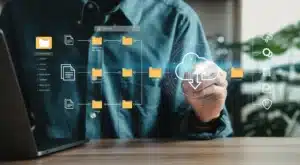Think of your home as a human body, where every smart device, from your smartphone to fitness tracking devices, to even your thermostat, is like a different body part. As each of your body parts performs a specific function, each device does a particular task. The lights can be eyes, a thermostat can be your body temperature, and a smartwatch is the heart that keeps your pulse rate in check.
But how do you think each body part works in harmony, and who keeps all these parts functioning together? It is the brain. And, in the world of technology, that brain is the cloud.
In this blog, I will tell you how and why the cloud is used. What is the role of cloud computing in IoT, and its various aspects, like application, benefits, integration, role, and more?
What is Cloud Computing in IoT?
Your everyday smart gadgets, such as watches, fitness trackers, electrical appliances, and even talking assistants, perform many functions. But the problem is that they can not process all the data from those functions on their own. And this is where cloud computing helps, you can think of the cloud as one big huge computer that can’t be seen, but it stores all your data using the internet on online servers. This data is also processed to give useful information that can be fruitful in taking necessary action. The data from your smart fitness device can be turned into a report for you to keep your health in check.
It becomes like a big connected family of smart devices that can talk to each other with the help of the internet. And we call it the Internet of Things (IoT).
IoT and cloud integration support real-time updates with smarter and faster services by helping devices communicate with each other. Whether it is about health monitoring, managing home appliances, or operating large-scale projects.

Cloud Computing and IoT Applications
1. Smart Homes
All the smart devices in your home, like smart ACs, lights, fans, security cameras, safes, and many more, are connected to the cloud. The cloud stores data and allows you to control the devices with apps from anywhere.
2. Healthcare
Wearables and digital smart devices, which help in tracking heart rates, sleeping cycle and quality, vitals, and more. Created data is stored on the cloud, and also analyzed, which is helpful for doctors to monitor patients in real-time. For example, elderly patients can be monitored while at home without visiting a hospital, except for severe scenarios.
Related: 10 Best AI Tools For Medical Researchers & Students
3. Smart Cities
The resources can be well used and managed by using IoT sensors in traffic lights, street lights, and waste bins, as the data can be collected on the cloud, and it can give insightful reports. By using the report, actionable steps can be taken to improve traffic flow, save energy, and manage the city. One example is where, by using cloud computing and IoT sensors in the signal lights, they can automatically change by determining traffic conditions in real-time.
4. Agriculture
The health of soil, weather conditions, and crop state can be understood with the help of IoT sensors. And this information generated by the sensors will be analyzed to use irrigation, fertilizers, and harvest in the best possible ways. Such as, smart irrigation systems can automatically turn on sprinklers if the soil is dry.
5. Automation in Industries
In industrial work, managing big machines is not a piece of cake, as one oversight can even cost someone’s life. Here, IoT sensors can play a crucial role in identifying issues like temperature, vibration, or any other errors that can be mistakenly overlooked manually.
6. Retail
With the help of smart shelves where IoT sensors are installed, the retailers can get alerts if the shelves are almost empty. Also, it helps track goods and manage them, and can personalize shopping by leveraging the data with cloud computing.
7. Transportation & Logistics
When you are in logistics and import & export business, you want your vehicles to run and deliver in the fastest and most efficient way. You can smartly use fuel and share locations for rerouting vehicles in case of heavy traffic jams. The IoT sensors can track and store data on the cloud and give insights to make the above things possible.
Limitations & Benefits of Cloud Computing in IoT
| Advantages | Disadvantages |
|---|---|
| Cloud computing for IoT scalability – You can add multiple devices without requiring any extra setup. | Security Risks – Data transmitted over the internet can be vulnerable to hacking. |
| Cost Efficiency – You pay as per your needs, which cuts the cost of maintenance and infrastructure. | Relies on Internet – There is a high reliance on the internet, and the systems can not function without a proper internet connection. |
| Real-Time Data Access – Access IoT data anytime, anywhere. | Latency Issues – Large systems and multiple apps are working, which can sometimes cause delays in data processing. |
| Centralized Management – You can manage, check, and take care of device updates by using a single platform. | Data Privacy Concerns – External servers are the ones storing your sensitive information. |
| Analytics & Insights – As I mentioned multiple times, storing and making the stored data actionable is the key aspect of cloud computing in IoT | Downtime Risks – Cloud service outages can affect device performance. |
| Faster Deployment – There is easy integration and connection of devices with the help of cloud APIs. | Vendor Lock-in – Migrating devices and data between cloud providers can be complex. |
| Automatic Updates – Cloud automatically updates software and firmware. | High Bandwidth Usage – Continuous data transfer can increase network load. |
| Disaster Recovery – As everything is on the cloud, just like the Google Drive, it makes it easy to perform data recovery in case of device failure. | Compliance Challenges – Cloud services need to follow and adhere to GDPR, which is challenging at times. |
| Edge-Cloud Synergy – Supports hybrid models where local processing reduces latency while cloud handles heavy computation. | Complex Integration – Integrating multiple IoT devices with the cloud can be technically challenging. |
| Energy Efficiency – When heavy computation is loaded off the small IoT devices, it reduces the energy burden on them. | Cost Overruns – Unexpected rise in data processing or storage can lead to high cloud costs. |
What are Cloud-Native IoT Applications?
When software is designed to run directly on the cloud (internet) instead of using local devices or traditional servers, without requiring any heavy on-premises infrastructure, it is called a cloud-native IoT application. Technologies like microservices, containers, and APIs are used in making these modern cloud applications. These are flexible, have high scalability, and are easier to update.
They are built in a way to scale automatically, process data in real time, and run with the changing demands. This makes them efficient in handling a large number of IoT devices. The simplest example is a smart home app to manage all your smart devices from the cloud server.
- They offer faster development and deployment
- Enhanced reliability and fault tolerance
- Easy to integrate with other cloud services and IoT devices
Also Read: Top 5 Market Intelligence Platforms for B2B Success
How Does Cloud Computing Support IoT Devices?
Cloud computing is a powerful brain for IoT devices that serves as a storage house for all the data generated by the devices. All your wearables and smart appliances, be it daily-use gadgets or large-scale machinery, create a large amount of data, but are not capable of processing that data.
Managing and monitoring devices and their updates without human intervention can be done by cloud computing. Moreover, it scales to handle thousands and millions of devices simultaneously, backing IoT systems for smooth functioning, smart work, and well-flowed communication. Analysis sends commands back to devices in real time to support necessary action.
Summing Up
As your body can’t function without the brain, neither can your IoT devices function to their optimum level without cloud computing. Cloud computing in IoT is the backbone of it, which makes it run smoothly in a faster, efficient, and smarter way. Cloud-native IoT applications are transforming how we work, live, and interact with technology. The intelligent IoT and cloud integration have made technological advancement more connected than ever.
Stay Connected! Stay Updated!
Related: What Is Paid Search Intelligence? Know All About It







